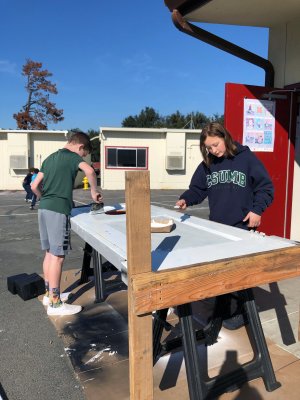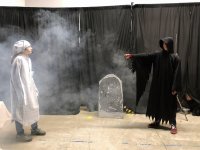How to Use a Play for Project-Based Learning
Seventh graders staging an adaptation of A Christmas Carol work on literary and historical analysis as well as the design process.
Your content has been saved!
Go to My Saved Content.I cut my teaching teeth on project-based learning, beginning my career at a school founded on PBL. Early on I attended the PBL World conference, and completed ongoing PBL professional development and support. As a result, I have a PBL mindset, frequently asking myself whether a given unit constitutes gold-standard PBL.
So when my seventh-grade students began a literary analysis unit that focused on Charles Dickens’s classic A Christmas Carol, I asked myself if we could turn this novella into a class play that was also high-quality PBL, with an authentic challenge, a dynamic driving question, and interdisciplinary learning.
The answer, it turned out, was yes. My students took a deep dive into literary and historical analysis and performing arts, with design process and engineering on the periphery. Some students worked on script writing while others worked on concessions to raise money. There was a little something for everyone.
An Authentic Learning Experience
As I was planning a different project, which focused on social justice, it occurred to me that there’s no better case study into the distribution of wealth, opportunity, and privilege than Victorian England. It was a time and place of unparalleled splendor and beauty and extreme wealth, and also of child labor, overflowing orphanages, unsafe working conditions, extreme poverty, debtors prisons, and union workhouses.
The moral, political, and economic lessons of Victorian England are still relevant today, and they are masterfully presented in the works of Dickens. From the point of view of seventh-grade accessibility, A Christmas Carol is perfect. We conducted research by reading several articles and watching film adaptations and documentaries. We were lucky to also be able to attend productions in San Francisco and Santa Cruz, as well as a Dickens Faire, but if attending a live performance isn’t feasible, teachers and students can find videos online.
The authentic challenge was twofold: First, my students would learn about social justice within a historical context, which would help them analyze our own society. The play created a lens through which to view class struggle, wage gaps, and several other social justice concerns. Second, they would share their new knowledge through a script-to-stage play, with an audience composed of their families and our school community.

Student Voice and Choice
I’m a humanities teacher, but I appreciate the design process and engineering, and it was with all of this in mind that I composed a driving question: How can we, as a comprehensive Victorian Age theater company, create a script-to-stage production of Charles Dickens’s A Christmas Carol, including an original adaptation, sets, props, costumes, music, posters, playbills, and acting, in order to show mastery of classic English literature, including complex themes, symbols, and other literary elements, as well as our understanding of social justice in Victorian England?
A mouthful, I know. When it’s broken into segments, seventh-grade students can fully understand it. That long driving question easily breaks down to a series of shorter questions: What’s our role? What are we doing? What exactly does that involve? What are the learning objectives? What makes this relevant?
In a unit on literary analysis, my students worked in teams that focused on exposition, internal and external conflict, rising action, climax, resolution, and theme. They had some voice and choice here—they learned about these elements together and then dug deeper into aspects that interested each of them the most. The internal conflict, Scrooge’s midnight black heart, and the themes of charity and mercy were the most popular, and the most relevant for our production.
Voice and choice were not only present but constituted the soul of this project. After reading and analyzing the novella, my students began working on their adaptation. How could they express their learning and teach embedded lessons on social justice if they worked with someone else’s adaptation?
They embedded moral lessons, funny anecdotes, and the most powerful of Dickens’s words. I gave them a skeleton script that outlined what they had studied, with the bare bones of exposition, setting up internal and external conflict, rising action, and climax. Small teams had a hand in composing their own lines, and then the script team and I put the pieces together. This included lots of original narration and decisions about singing Christmas carols as part of the play. My students are fortunate to have music and drama experience in their K–6 enrichment courses before they enter seventh grade.
They designed and 3D-printed a door knocker, built a bed, and made or procured costumes and props. They built Scrooge’s front door and Tiny Tim’s crutch. All of this work involved critique and revision. It also took a lot of time. But in the world of education everything is a trade-off, and I’ve yet to see a more dynamic student experience in the month of December. In hyperbolic Dickensian language, my students did it all, and more.
Public Product and Reflection
In true Victorian fashion, my students sold warm mixed nuts and popcorn at the show to cover the cost of producing the play. The popcorn and nuts were donated, and we raised almost $500, which was about the cost of the production.
The students taught, and inspired, their families and peers, demonstrating their expertise. In the course of the play, they used a fog machine, danced, sang carols, played instruments, and had a snowball fight. It was a lot of fun.
When students design from the ground up, the public product—in this case a performance—highlights who they are, what they know, and their individual talents and ambitions.
